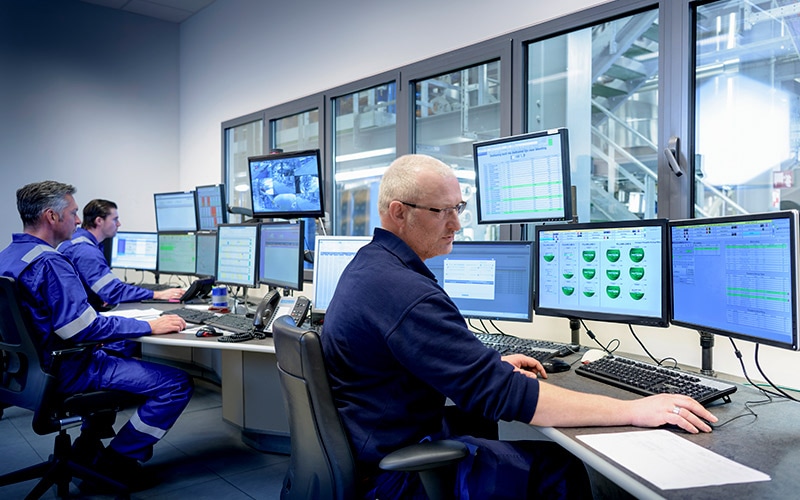Insights
- More than 100 telecom firms worldwide have set net-zero goals or commitments through the Science Based Targets initiative.
- Telecom electricity usage accounts for roughly 90% of the industry’s network costs and adds up to between 2% and 3% of the world’s energy use.
- A practical decarbonization model includes four key elements: energy efficiency, electricity decarbonization, fuel decarbonization, and carbon capture.
- The proliferation of digital technology, like IoT devices running on 5G millimeter-wave frequency, is expected to increase energy demand.
- A command center approach to emissions and energy unifies disparate systems into a common view that shows operational health.
- Energy management platforms allow companies to track, visualize, and compare KPIs for energy consumption. They can also compare greenhouse gas emissions among sites, integrate with third-party ESG compliance systems, and provide role-specific information.
A sustainable way forward for the telecom industry
Telecommunications companies have taken a strong stand to align themselves with the Paris Agreement’s goal to limit global warming. Through industry consortiums like the Global Enabling Sustainability Initiative, industry leaders have committed to reach net zero for scope 1 and 2 emissions by 2030, and all scopes by 2040. Additionally, more than 100 telecom firms worldwide have set net-zero targets or commitments through the Science Based Targets initiative, a partnership that includes the United Nations Global Compact.
To reach these ambitious goals, telecom companies must address their enormous energy use and the emissions challenges that result.
Telecom electricity usage accounts for roughly 90% of the industry’s network costs and adds up to between 2% and 3% of the world’s energy use.
Firms must now simultaneously manage energy costs and slash emissions, all while expanding their networks to reach new and more demanding customers. Connected devices are expected to grow massively in the coming decade. Internet of things (IoT) devices are projected to reach 29 billion in 2030 (up from 13 billion in 2022) as the 5G ecosystem matures. Researchers have estimated that this could lead to a 160% increase in energy demand by the sector.
The pressure of their rapidly approaching 2030 net-zero commitment for scope 2 emissions (purchased energy) is close to a boiling point, leaving telecoms searching for sustainable practices and technologies that can solve their energy and environmental dilemma.
A model to understand decarbonization

Telecom companies face a decarbonization problem that only stands to get worse without a structural shift. By adopting a practical decarbonization model, telecom companies can diagnose issues, identify opportunities, and develop a plan to significantly reduce emissions and meet their public commitments.
There is not a one-time solution to decarbonization. This effort requires a multipronged, continuous approach that addresses all of an enterprise’s scope emissions (Figure 1).
Figure 1. A practical decarbonization model

Source: Infosys
This model shows the four most critical actions required to solve the industry’s decarbonization challenge.
- Energy efficiency — Increase facility efficiency, including data center power usage efficiency, and optimize energy required to deliver signals throughout the distribution network.
- Electricity decarbonization — Invest in renewables through power purchase agreements.
- Fuel decarbonization — Prioritize remote and over-the-air provisioning of consumer equipment to reduce customer visits and decrease transportation fuel emissions. In addition, companies should use electric vehicles or nonfossil fuels, such as green hydrogen, for vehicles when customer visits can’t be avoided.
- Carbon capture — Indirectly attack embodied carbon from device manufacturing, packaging, and recycling through product lifecycle management. This is needed when reducing carbon is not possible.
While these four elements make decarbonization seem like a herculean effort, we have found that existing technologies provide practical solutions. The types of interventions above illustrate the steps that will lead telecom companies beyond carbon neutrality to attain their verifiable net-zero goals.
Disparate systems and manual processes
Telecom networks are vast and various in their infrastructure and systems. Network operators manage radio towers that connect devices, headends that ensure the delivery of content, and the service systems that maintain the network. T-Mobile’s US 5G network alone covered 1.9 million square miles as of 2023.
Despite advances in automation and smart technology, some industry processes and actions are still manual, especially with agent-assisted customer service and provisioning of mobile devices. However, when dealing with telecom networks, system efficiencies and innovation are often isolated and not shared throughout a network. For example, someone managing a headend could decide to retire or consolidate old, inefficient equipment to lower energy usage. But the processes created and lessons learned might not reach the rest of the enterprise.
Companies need to move away from manual processes and pull their varied systems into a unified view. The proliferation of digital technology, like IoT devices running on 5G millimeter-wave frequency, could increase energy demand. Even so, these same technologies could also offer solutions.
In one case, a global IT company avoided $185 million of energy costs and 1.45 million tons of carbon over eight years by using IoT smart energy monitoring.
A technology-led command center approach

At Infosys, we found a highly effective way to address emissions and energy: Unify disparate systems into a common view that shows operational health. This is what we refer to as a command center approach. We used this data-driven path in our own journey to carbon neutrality. Through a range of sensors that measure KPIs, such as energy usage, temperature, and emissions, we turned our built world into a digital twin. This allowed us to understand the life of our systems, where even slight performance deviations are identified and resolved.
These kinds of capabilities can be found in energy management platforms (EMPs) that allow businesses to better understand their energy usage. These tools are particularly valuable for telecom companies, where operations cover vast geographies. An EMP allows enterprises to see how much energy is being used across the entire network, from headends to radio access towers. This approach is critical to understanding where energy is currently — and historically — consumed. The steady stream of data allows for better troubleshooting and optimization.
An EMP includes:
- Capability to track, visualize, and compare KPIs for energy consumption at summary and detail locations.
- Comparisons of greenhouse gas (GHG) emissions among sites, at varying time intervals (near real-time, hourly, daily) based on energy consumption.
- Ability to host on various cloud computing providers to take advantage of sustainability calculation tools.
- Integration of data with third-party ESG compliance systems, such as IBM Envizi and SAP, to ingest and automate sustainability accounting for electricity.
- Role-specific views that provide relevant information for each user type. For example, the electrical manager needs a detailed analysis of the equipment and energy consumption whereas a leadership team needs to know system-wide summaries.
As a result, EMPs can improve network resilience, reduce costs, and assist in meeting sustainability goals.
Network resilience — The solution can alert a company about issues at individual sites, which often prevent small problems from becoming outages. When a location uses more electricity than usual, that is a potential warning sign. Elevated energy use is often the result of active cooling for equipment that is overloaded or close to failure. After an alert is triggered, trouble tickets are created automatically and assigned to technicians to investigate potential problems before they become failures.
Reduce costs — A company can optimize its energy usage only when it understands the flow of electrons. EMPs allow enterprises to calculate their energy cost index and energy consumed per square foot. Some comparison tools give users a quick visualization of energy used, costs estimates, and the ability to share the data as reports.
Sustainability goals — An EMP creates a continual health check for the energy foundation, which is crucial to this sector in transmitting data signals. These platforms can track the energy used per subscriber, per terabyte transmitted, and ultimately estimate the GHG impact. Further, the EMP can provide information on the renewables vs. nonrenewable energy mix. This on-demand data is a major step towards tracking efforts to meet sustainability goals.
Telecom companies find themselves in both an enviable position and difficult bind. 5G and other new technologies open communication possibilities that were once the musings of futurists. However, those ever-growing networks — and the energy usage that results — threaten to create new, higher barriers to reaching net-zero goals.
With deadlines looming, the telecom industry needs to embrace an approach that combines energy management technology with a solid decarbonization model. Combined, these can lay out a path toward greater sustainability as well as operational stability and cost savings. This is only the start, but successful decarbonization journeys must begin with the right tools for the job and an understanding of how best to use them.




